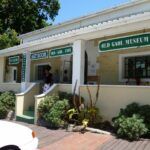The old Gaol
James Fichat, the Civil Commissioner for the Cape Colony and resident magistrate for the Knysna area set about obtaining plans for building a jail on the orders of Sir George Grey (Governor of the Cape Colony from 1854 to 1861). Knysna was in need of a jail. Thomas Bain, the great roads engineer was planning to use convict labour to build the Prince Alfred’s Pass which now links Knysna with Uniondale. The first group of 50 convicts who would build the jail arrived aboard the privately-owned steamer, ss Zulu, on 21 August 1858. The prisoners had come from Zuurberg in the Eastern Cape. They stayed in Knysna in a wooden store on the farm Melkhoutkraal.
The foundation stone was laid on 19 February 1859. Many of the builders were Malay Muslims and they sprinkled water on and under the foundation stone. Mr. Fichat made a speech, the Reverend Squibb led the spectators in prayer and the Freemasons performed some rituals.
The gaol had eight cells, quarters for wardens, kitchens, a hospital facility, and storerooms.
As the gaol was the only government building, it became a centre of village life. From 1883 the bell was used as a fire alarm. As the goal was a government building it received piped water when it was introduced in 1902. This enabled the garden at the gaol to be quite a showpiece.
In the 1980s a new prison was opened and the old gaol building became an art complex where exhibitions were held. It is now part of the museum complex of four historic buildings on the corner of Queen and Clyde Streets – Millwood House, Parkes Shop, Parkes Cottage, and the Pitt Street House).
24 Queen Street, Knysna
.


